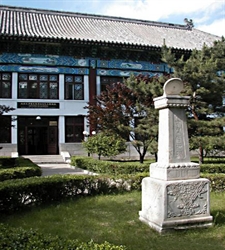News & Events | About PKU News | Contact | Site Search
PKU Today in History - a daily column featuring historic events regarding PKU and PKUers.
1926 - Strong Objection to the Ultimatum from the Eight Powers
Peking University (PKU), together with tens of thousands from many other organizations, convened an assembly at Tian’anmen Square to protest the Eight-power Ultimatum on March 18, 1926. Afterwards, a demonstration was held to present their petition to the executive government. However, the bodyguard fired at the masses, resulting in 47 deaths, including three PKU students: Zhang Zhongchao, Huang Keren, and Li Jiazhen.
1985 - Establishment of the Arthur M. Sackler Museum of Art and Archeology at PKU
The Ministry of Education sent an official reply on March 18, 1985, approving PKU's acceptance of the $1,250,000 contribution from Dr. Arthur M. Sackler to establish a museum of art and archaeology on campus. The museum, covering 3,900 square meters, was finally named after its donor.

The Arthur M. Sackler Museum of Art and Archeology (File photo)
The Ministry of Education sent an official reply on March 18, 1985, approving PKU’s acceptance of a $1,250,000 contribution from Dr. Arthur M. Sackler to establish a museum of art and archaeology on campus. The museum, covering 3900 square meters, was named after its donator.
Arthur M. Sackler Museum of Art and Archaeology at PKU is the first museum at a Chinese university to feature archaeology. Devoted to education, research, and social service, the museum has provides students majoring in Chinese archaeology and museum science with unique study and internship opportunities. Additionally, the museum assists the study of Chinese archaeology a great deal, serving both to demonstrate achievements in the field and to publicize archaeological knowledge. Interestingly, while the museum plays a significant role in promoting and developing Chinese traditional culture, by enhancing international communication in various academic spheres, it also facilitates the development of understanding and friendship among scholars and laymen interested in archeology worldwide.
A piece of Tang Tri-colored pottery (Sackler Museum)
Arthur M. Sackler Museum of Art and Archaeology at PKU now possesses over ten thousand valuable artifacts, most typical specimens of China’s different ancient periods, including Peking Man era stone wares from Zhoukoudian, representative implements belonging to diverse Neolithic archaeology cultures, Shang Dynasty oracle bone inscriptions, bronze and jade from the Xizhou Dynasty, as well as pottery and coins. The first batch of artifacts was received from PKU’s Institute of Archeology nearly a century ago. More came from PKU Museum and Yenching University. After the 1950s, the museum gradually accumulated cultural relics and antiquities from museums at home and abroad with the help of different archaeology agencies, greatly enhancing its storage.
Translated by: Duan Ranjia
Edited by: Arthars
Source: PKU News (Chinese)